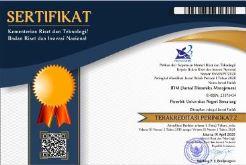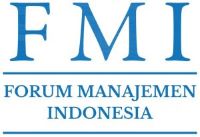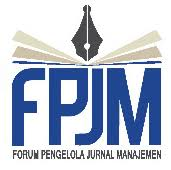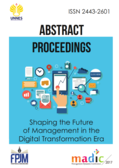Switching Expression or Emotion: Emotional Labor Strategy on Negative Word of Mouth Mediated by Customer Satisfaction
Abstract
Keywords
Full Text:
PDFReferences
Anderson, E. (1998). Customer Satisfaction and Word of Mouth. Journal of Service Research, 1(1), 5-17.
Bakar, R. M., & Himam, F. (2009). Efektivitas Pelatihan Pelayanan dalam Meningkatkan Pengetahuan Pelayanan, Kualitas Pelayanan, dan Kepuasan Pengguna Perpustakaan. Jurnal Intervensi Psikologi, 1(2), 179-194.
Barrett, L. F., & Bliss-Moreau, E. (2009). She’s Emotional. He’s Having a Bad Day: Attributional Explanations for Emotion Stereotypes. Emotion, 9(5), 649-658.
Brotheridge, C. M., & Lee, R. T. (2002). Testing a Conservation of Resources Model of the Dynamics of Emotional Labor. Journal of Occupational Health Psychology, 7(1), 57-67.
Casidy, R., & Shin, H. (2015). The Effects of Harm Directions and Service Recovery Strategies on Customer Forgiveness and Negative Word-of-Mouth Intentions. Journal of Retailing and Consumer Services, 27(11), 103-112.
Cho, Y., Rutherford, B. N., & Park, J. (2013). The Impact of Emotional Labor in a Retail Environment. Journal of Business Research, 66(5), 670-677.
Demetriou, H., Wilson, E., & Winterbottom, M. (2009). The Role of Emotion in Teaching: are there Differences Between Male and Female Newly Qualified Teachers’ Approaches to Teaching? Educational Studies, 35(4), 449-473.
Du, J., Fan, X., & Feng, T. (2011). Multiple Emotional Contagions in Service Encounters. Journal of the Academy of Marketing Science, 39(3), 449-466.
East, R., Hammond, K., & Lomax, W. (2008). Measuring the Impact of Positive and Negative Word of Mouth on Brand Purchase Probability. Prisma Social, 25(3), 215-224.
Elliott, D., & Charlton, L. (2016). A Preliminary Investigation Into the Use of the Emotional Contagion Effect in the Exercise Environment. Comprehensive Psychology, 5, 1-9.
Grandey, A. A. (2000). Emotion Regulation in the Workplace: a New Way to Conceptualize Emotional Labor. Journal of Occupational Health Psychology, 5(1), 95-110.
Grandey, A. A. (2003). When “the Show Must Go onâ€: Surface Acting and Deep Acting as Determinants of Emotional Exhaustion and Peer-Rated Service Delievery. Academy of Management Journal, 46(1), 86-96.
Grandey, A. A., Fisk, G. M., Mattila, A. S., Jansen, K. J., & Sideman, L. A. (2005). Is “Service with a Smile†Enough? Authenticity of Positive Displays During Service Encounters. Organizational Behavior and Human Decision Processes, 96(1), 38-55.
Grégoire, Y., Tripp, T. M., & Legoux, R. (2009). When Customer Love turns into Lasting Hate: the Effects of Relationship Strength and Time on Customer Revenge and Avoidance. Journal of marketing, 73(6), 18-32.
Groth, M., & Hennig-Thurau, T. (2009). Customer Reactions to Emotional Labor: the Roles of Employee Acting Strategies and Customer Detection Accuracy. Academy of Management Journal, 52(5), 958-974.
Ha, Y. W., & Park, M. C. (2013). Antecedents of Customer Satisfaction and Customer Loyalty for Emerging Devices in the Initial Market of Korea: an Equity Framework. Psychology and Marketing, 30(8), 676-680.
Hatfield, E., Cacioppo, J. T., & Rapson, R. L. (1993). Emotional Contagion. Current Directions in Psychological Science, 2(3), 96–100.
Hatfield, E., Cacioppo, J. T., & Rapson, R. L. (1994). Emotional Contagion: Studies in Emotion and Social Interaction. United Stated of America: Cambridge University Press.
Hennig-Thurau, T., Groth, M., Paul, M., & Gremler, D. D. (2006). Are All Smiles Created Equal? How Emotional Contagion and Emotional Labor Affect Service Relationships. Journal of Marketing, 70(3), 58-73.
Hochschild, A. R. (1983). The Managed Heart: Commercialization of Human Feeling. California: University of California Press.
Holmes, J. H., & Lett, J. D. (1977). Product Sampling and Word of Mouth. Journal of Advertising Research, 17(5), 35-40.
Huang, P.-F., & Dai, C.-W. (2010). The Impacts of Emotional Contagion and Emotional Labor Perception on Employees’ Service Performance. International Journal of Electronic Business Management, 8(1), 68-79.
Hülsheger, U. R., Lang, J. W. B., & Günter, W. M. (2010). Emotional Labor, Strain, and Performance: Testing Reciprocal Relationships in a Longitudinal Panel Study. Journal of Occupational Health Psychology, 15(4), 505-521.
Iglesias, O., Markovic, S., & Rialp, J. (2019). How Does Sensory Brand Experience Influence Brand Equity? Considering the Roles of Customer Satisfaction, Customer Affective Commitment, and Employee Empathy. Journal of Business Research, 96(3), 343-354.
Ismoyo, N. B., Hadiwidjojo, D., Rahman, F., & Rahayu, M. (2017). Service Quality Perception’s Effect on Customer Satisfaction and Repurchase Intention. European Business and Management, 3(3), 37-46.
Keller, E. D. (2007). Unleashing the Power of Word Of Mouth: Creating Brand Advocacy to Drive Growth. Journal of Advertising Research, 47(4), 448-452.
King, R. A., Racherla, P., & Bush, V. D. (2014). What We Know and Don’t Know About Online Word-of-Mouth : a Review and Synthesis of the Literature. Journal of Interactive Marketing, 28(3), 167-183.
Kruml, S. M., & Geddes, D. (2014). Exploring the Dimensions of Emotional Labor : the Heart of Hochschild’S Work Exploring the Dimensions of Emotional Labor. Management Communication Quarterly, 14(1), 8-51.
Lewis, K. M. (2000). When Leaders Display Emotion: How Followers Respond to Negative Emotional Expression of Male and Female Leaders. Journal of Organizational Behavior, 21(2), 221-234.
Liu, Y., Perrewé, P. L., Hochwarter, W. A., & Kacmar, C. J. (2004). Dispositional Antecedents and Consequences of Emotional Labor at Work. Journal of Leadership & Organizational Studies, 10(4), 12-25.
Luarn, P., Huang, P., Chiu, Y. P., & Chen, I. J. (2016). Motivations to Engage in Word-of-Mouth Behavior on Social Network Sites. Information Development, 32(4), 1253-1265.
Mazzarol, T., Sweeney, J. C., & Soutar, G. N. (2007). Conceptualizing Word-of-Mouth Activity, Triggers and Conditions: an Exploratory Study. European Journal of Marketing, 41(11), 1475-1494.
Mesmer-Magnus, J. R., Dechurch, L. A., & Wax, A. (2011). Moving Emotional Labor Beyond Surface and Deep Acting: a Discordance- Congruence Perspective. Organizational Psychology Review, 2(1), 6-53.
Neves, L., Cordeiro, C., Scott, S. K., Castro, S. L., & Lima, C. F. (2018). High Emotional Contagion and Empathy are Associated with Enhanced Detection of Emotional Authenticity in Laughter. Quarterly Journal of Experimental Psychology, 71(11), 2355-2363.
Nguyen, H. T., Nguyen, H., Nguyen, N. D., & Phan, A. C. (2018). Determinants of Customer Satisfaction and Loyalty in Vietnamese Life-Insurance Setting. Sustainability, 10(4), 1-16.
Nolen-Hoeksema, S. K. (2012). Emotion Regulation and Psychopathology: the Role of Gender. The Annual Review of Clinical Psychology, 8(1), 161-187.
Oliver, R. L. (1999). Whence Consumer Loyalty? Journal of Marketing, 639(1), 33-44.
Ranaweera, C., & Prabhu, J. (2003). On the Relative Importance of Customer Satisfaction and Trust as Determinants of Customer Retention and Positive Word of Mouth. Journal of Targeting, Measurement and Analysis for marketing, 12(1), 82-90.
Sivadas, E., & Jindal, R. P. (2017). Alternative Measures of Satisfaction and Word of Mouth. Journal of Services Marketing, 31(2), 119-130.
Söderlund, M. (1998). Customer Satisfaction and its Consequences on Customer Behavior Revisited: the Impact of Different Levels of Satisfaction on Word-of-Mouth, Feedback to the Supplier and Loyalty. International Journal of Service Management Industry, 9(2), 169-188.
Suchánek, P., Richter, J., & Králová, M. (2015). Customer Satisfaction, Product Quality and Performance of Company. Review of Economic Perspective, 14(4), 329-344.
Suchánek, P., Richter, J., & Králová, M. (2017). Customer Satisfaction with Quality of Products of Food Busines. Journal of Prague Economic Papers, 26(1), 19-35.
Szymanski, D. M., & Henard, D. H. (2001). Customer Satisfaction: a Meta-Analysis of the Empirical Evidence. Journal of the Academy of Marketing Science, 29(1), 16-35.
Taber, K. S. (2018). The use of Cronbach’s alpha when developing and reporting research instruments in science education. Research in Science Education, 48(6), 1273-1296.
Taghizadeh, H., Taghipourian, M. J., & Khazaei, A. (2013). The Effect of Customer Satisfaction on Word of Mouth Communication. Research Journal of Applied Sciences, Engineering and Technology, 5(8), 2569-2575.
Tsai, W. C. (2001). Determinants and Consequences of Employee Displayed Positive Emotions. Journal of Management, 27(4), 497-512.
Vázquez-Casielles, R., Suárez-Ãlvarez, L., & RÃo-Lanza, A.-B. (2013). The Word of Mouth Dynamic : How Positive (and Negative) Wom Drives Purchase Probability an Analysis of Interpersonal and Non-Interpersonal Factors. Journal of Advertising Research, 53(1), 43-60.
Wangenheim, F. (2005). Postswitching Negative Word of Mouth. Journal of Service Research, 8(1), 67-78.
Yasvari, T. H., Ghassemi, R. A., & Rahrovy, E. (2012). Influential Factors on Word of Mouth in Service Industries (the Case of Iran Airline Company ). International Journal of Learning and Development, 2(5), 227–242.
View Counter: Abstract - 780 and PDF - 561
Refbacks
- There are currently no refbacks.





